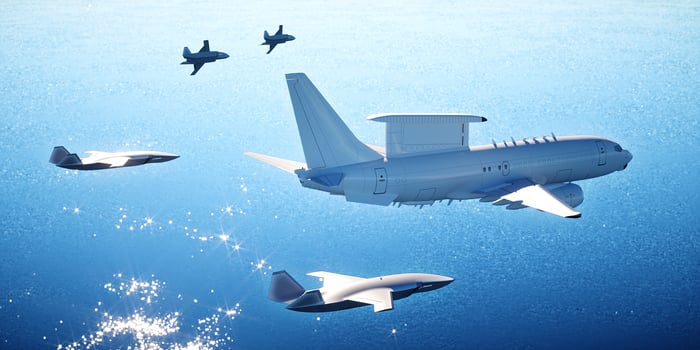Boeing (BA -0.20%) has officially entered the race to produce an unmanned "wingman" drone, as it unveiled a fighter-like aircraft designed to fly alongside warplanes and increase Air Force resources at a fraction of the cost of sophisticated crewed fighters.
The company's Boeing Airpower Teaming System was introduced at an air show in Australia, where the aircraft was developed. The Pentagon and allied armed forces are keen on the wingman concept as a way to increase their resources, with military planners envisioning unmanned aircraft flying into warzones that are unsafe for piloted aircraft or overwhelming enemy radar systems to help shield and protect more-expensive aircraft, including the F-35 Joint Strike Fighter.

Prototype of Boeing's Airpower Teaming System drone on display in Australia. Image source: Boeing.
The reveal is a big moment for Boeing, but it is also a shot across the bow at rivals including Lockheed Martin and Kratos Defense & Security Solutions (KTOS 0.68%) that are each developing similar concepts. Kratos in particular should be watching closely, as it is a smaller company without the vast global sales force Boeing can deploy, and its valuation is reliant on the success of its drone offerings.
Check out the latest earnings call transcript for Boeing.
A partner in the skies
The Boeing aircraft measures 38 feet long and should be able to fly more than 2,000 nautical miles between refuelings. It's equipped with an integrated sensor package to support intelligence, surveillance, and reconnaissance missions and electronic warfare, and is designed to be able to both fly independently or in support of crewed aircraft. The jet is designed for standard runway takeoffs and landings but can be modified for carrier operations.
The Air Force Research Laboratory has been funding work into so-called "loyal wingman" designs since at least 2016, looking for cost-effective ways to maximize its force and to remove pilots from harm's way when possible.
Boeing did not say how much it has invested in the development or how much it expects the system to cost. But the drone is expected to be significantly cheaper than the F-35, which is currently selling for more than $81 million per frame.
The aircraft was developed in Australia and Boeing intends to build it there. While U.S. military export policies tend to change with each new administration, the company could find it easier to sell to a wide range of partners from Australia than it would from the U.S.
Crowded skies
Boeing's wingman drone is intriguing, but the company still has some catching up to do if its Airpower Teaming System is to win orders. First flight is not expected until 2020. By then, rivals including Kratos might already have secured international orders.
Kratos last year won U.S. State Department approval to market its Mako drone platform internationally. The Mako completed its first test flight in 2017 and is currently being marketed to U.S. allies that are F-35 operators at a price of less than $3 million per unit. A separate, more advanced model, the Valkyrie, is expected to make its first flight in the weeks to come.
Lockheed Martin meanwhile has been flexing its artificial intelligence chops with its wingman efforts. The company in 2017 successfully demonstrated an autonomous F-16 flying in formation with crewed jets, including testing the autonomous plane's ability to execute air-to-ground strikes and to adapt to a changing threat environment.
So who wins?
Boeing vs. Kratos is shaping up as an interesting dogfight. Boeing comes to the fight with a long list of international relationships and business partners, and in Australia seemingly has a valuable launch customer that could establish the aircraft as the standard for an entire region to follow. Kratos, however, has first-mover advantage, and existing experience selling its targeting drones internationally to the United Kingdom, South Korea, and Sweden, among other countries.
There are design differences as well. The Kratos drones, borrowing from the company's experience making targeting aircraft, can be launched like a rocket without a runway. The Boeing craft is slightly larger and should be able to carry a larger payload of weaponry or sensors.

Rendering of Boeing's Airpower Teaming System drone flying with an AEW&C reconnaissance aircraft. Image source: Boeing.
A Kratos exec speaking to reporters at the Australian air show said he believes the use cases for the Boeing and Kratos drones are different, saying the two designs can complement each other in a war zone.
My sense is this is a market big enough for two or more participants, given the rapid advances in artificial intelligence and autonomous system sophistication and the demand by cash-strapped militaries to expand their capabilities on the cheap. If Kratos and Boeing and other potential competitors like Lockheed can deliver systems that live up to the hype, there will be buyers interested in their products.
For the much larger Boeing the stakes are much smaller, but the company has a large and growing portfolio of autonomous air and sea systems that should position it well for the future. As for Kratos, if it wasn't clear the company's drones would face competition before, it certainly is clear now.
Kratos is undeniably a higher-risk/reward type of investment, while Boeing is a more staid and predictable stock. But for a risk-tolerant investor, the shift toward autonomous systems makes both intriguing long-term investments.





